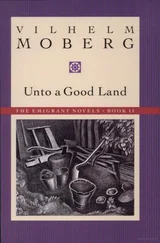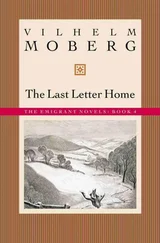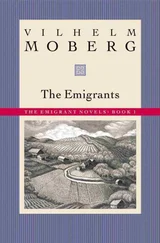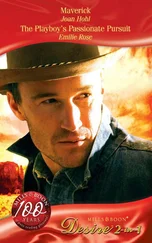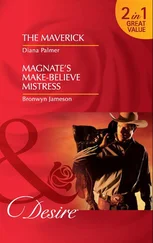Thirty dollars was cheap for a thirteen-hand ox but the company manager accepted the offer even though the whole sum was not in cash.
“I trust you, Mr. Nilsson!” he said.
This was the first time in America that Karl Oskar had received credit. Before, when he asked for a few nails or a spool of thread, cash had been required. In his dealings with people, no one had trusted him until today. He felt as if he had been singled out for an honor, even though the sum was only ten dollars. As a squatter he had managed to remain on his claim for three years — perhaps the Americans at last realized that he intended to stay.
So Karl Oskar returned to Duvemåla the owner of a sturdy old ox. The beast had an enormous belly, his horns were thick and nicely curved, his coat black with a white spot in the middle of his forehead like a shining star. A stone-hard enlargement on the neck, with the fur entirely worn off, told of the many heavy loads this ox had pulled; this yoke mark, the bald lump, was the beast’s letter of recommendation.
“That’s a lordly ox!” exclaimed Kristina as Karl Oskar came up, leading the animal. It had a lumbering walk, moving slowly, one foot after the other, but it held its horn-crowned head proudly in the air. It was indeed a lord among oxen.
From a thick oak log Karl Oskar sawed off four trundles — the wheels of a settler’s wagon; he also made a single yoke for the ox’s neck. Now he had his own wagon and his own beast to pull it.
Up to now he had shared the lot of cotters and other poor people back in Sweden, who walked and carried their burdens on their backs, while the farmers loaded theirs on their wagons riding and snapping their whips confidently. After only three years on his claim he could now ride his own ox wagon and feel like a farmer who owned something in America.
Petrus Olausson came to inspect his neighbor’s new beast: “I too will buy an ox! Then we can team up and break land together.”
A few days later Olausson came home with a thirteen-hand ox, entirely white, that he had bought in Stillwater.
Karl Oskar measured the animal and said, “Our team is the strongest in the whole valley!”
The two men yoked the black and the white oxen together and helped each other break new fields during the fall, plowing the same number of days on each claim. They used Olausson’s plow, which had an iron bill and cut deeper than Karl Oskar’s wooden plow; but however deep they plowed, the team managed.
Before the frost came and stopped their work, Karl Oskar had added five more acres to his field. Already he had more acres to seed than he had had in Sweden.
The black ox became their most valued and beloved animal. He was strong, good-natured, untiring. Standing there, sated with rich grass, chewing his cud which dripped down the tuft of his chin, he was a picture of true contentment. His enormous belly was round as a barrel, he was heavy and immobile as a huge boulder, encompassed in a superior calm which nothing in the world could disturb. The black ox radiated his security to his owners.
Karl Oskar named the beast Starkodder. It was a name he had taken from the saga of a brave Viking; Starkodder had been a hero strong as three men and endowed by the god Odin with a life span of three ordinary humans. It was the hero’s strength Karl Oskar had in mind when he named his ox. The saga warrior had also been headstrong, unruly, evil-tempered; when at last he fell in combat, his decapitated head had bitten into the turf and chewed the earth angrily.
Thus the temperament of the Viking did not fit the ox Starkodder, who was calm and tractable in all his activities. He became the Nilssons’ devoted helper, breaking their land, pulling home their supplies, and relieving them of much drudgery. They lifted their burdens off their shoulders and backs and laid them all onto his neck; everything was loaded on his bald, thick neck-swelling. And the old beast received it all patiently.
Starkodder was a sacrificial animal: he sacrificed himself for them.
— 2—
Pastor Erland Törner had stayed with the Swedes in the St. Croix Valley and had conducted services throughout the summer and fall. Now he was recalled to the Swedish settlement in Moline, Illinois, where newly arrived immigrants had brought cholera with them. It had raged among the settlers, who urged his return, for there were no ministers to conduct funeral rites. The timber and boards purchased for the new church in Moline were now being used for coffins for the cholera victims. Decent death couches and resting ground must be found for the dead ones before a house of prayer could be built for the living. The Illinois settlers found no time for their autumn plowing, for they spent their days digging graves in death’s field. Instead of sowing their winter wheat they now put friends and neighbors into the earth. A minister would have much to do in Moline and Galesburg and neighboring villages, and Pastor Törner intended to remain through the winter. His mission to the St. Croix Valley had been to give spiritual comfort to the settlers and lay the foundation for a Lutheran congregation. Now as he was about to leave the Swedes, they wished to pay him for his sermons. They collected twenty dollars for the young pastor, a dollar or two from each homestead.
When Kristina learned that Pastor Törner was to move away she made a decision: she would ask him to church her before he left. She regretted she had not asked him to perform this ritual the first day he came to their house; she ought not to have received Holy Communion without first being cleansed from her childbed. But now at last it would take place.
She made her decision a little too late; the following day she discovered she was pregnant.
No minister would church a woman who was again carrying a life. And here she was, pregnant without being cleansed and blessed from her earlier birth, so indifferent and negligent had she become in religious matters. How would God view her neglect? Would he make a special dispensation for a settler wife who had both participated in the Lord’s Supper and become pregnant again without churching?
Almost three years had passed since the birth of her youngest child and she had hoped it was her last. Her fervent wish was to remain barren for the rest of her life. She had already borne six children, four of whom were living, and she would be twenty-eight next St. Michael’s Mass. The strain of so many pregnancies and the heavy work over the years had begun to leave their marks on her. The bloom of youth was gone, her rounded girl-cheeks thinner, her face lined with wrinkles. Recently she had lost her front tooth, and as she showed it, lying in her palm, to Karl Oskar she said, “This is the first sign of old age.”
He replied that they had gone through so much, as emigrants, that they were in reality older in body and soul than those of the same age who had remained at home.
This would be her seventh child. Her concern for her children would now have to be shared by one more, and she felt depressed not only for her own sake, but for the children’s sake. The more of them there were, the less each could expect.
If she and her husband stayed apart, she would not become pregnant again, but the holy bonds of matrimony intended that they should know each other bodily and beget children. God wanted them to enjoy each other in that way. And the physical attraction was so powerful between Karl Oskar and herself that they couldn’t stay away from each other for long. What took place between them was according to the Almighty’s will; through them He created new people. And now He had again created a life in her. What could she do about it? It would be sinful to attempt to avoid pregnancies by such devices as long breast-feeding. No one could expect to fool God with such tricks.
Читать дальше

